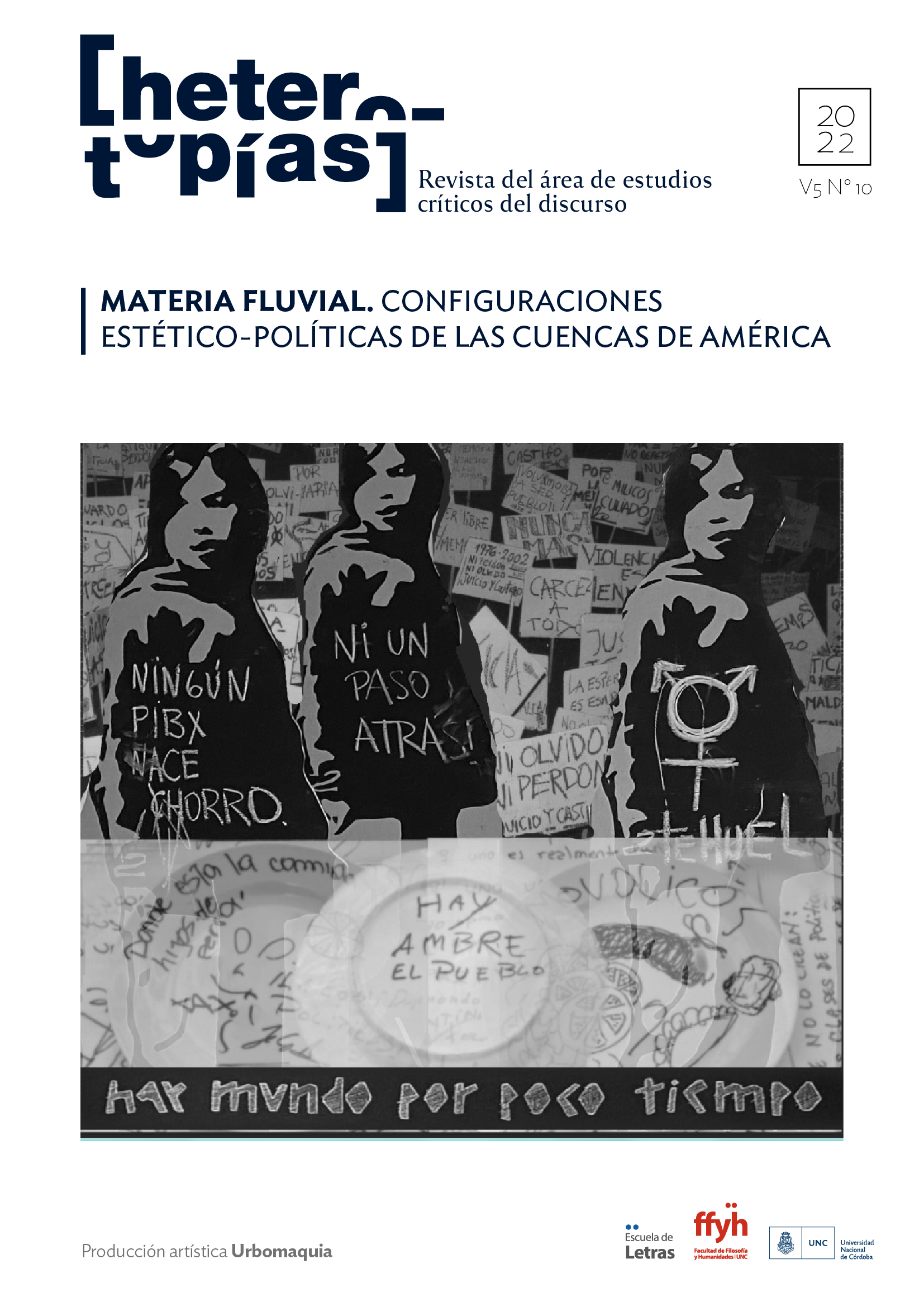Sensitive force in the patagonian mallines
Main Article Content
Abstract
The present article is an inquiry into the sensitive force that is configured in the fluvial prints made by the Argentinean artist Teresa Pereda in the wetlands of Patagonia. I seek to argue that, under a logic of immersion, which reconfigures the coordinates of the aesthetic gesture, these papers trace a form of action in which unexpected alliances weave a material imaginary that attends to an organic and mineral universe rather than a human one. In turn, I postulate that by means of operations and movements that escape conscious intervention, these impressions manifest an aesthetic-politics of the material-fluvial in which the non-identity force of sensitive practices is re(inscribed). To support these ideas, I use in this article a contemporary theoretical constellation that attends to the material and aesthetic efficacy of all that exists in order to point out the importance of the aesthetic-artistic productions in the configuration of a political ecology.
Downloads
Article Details

This work is licensed under a Creative Commons Attribution-NonCommercial-ShareAlike 4.0 International License.
Those authors who have publications with this journal, accept the following terms: Those authors who have publications with this journal, accept the following terms:
a. The authors will keep their copyright and guarantee to the journal the right of first publication of their work, which will be simultaneously subject to the Creative Commons Attribution - Non-Commercial - Share Alike (by-nc-sa) Attribution License; no commercial use of the original work or any derivative works is allowed, the distribution of which must be done with a license equal to the one that regulates the original work.
b. Authors may adopt other non-exclusive license agreements for the distribution of the published version of the work (e.g., deposit it in an institutional telematic archive or publish it in a monographic volume) provided that the initial publication in this journal is indicated.
c. Authors are allowed and recommended to disseminate their work through the Internet (e.g. in institutional telematic archives or on their website) before and during the submission process, which may lead to interesting exchanges and increase the number of citations of the published work. (See The effect of open access).
How to Cite
References
Abram, D. (2010). Becoming animal. An Earthly Cosmology. Nueva York, EE. UU.: Vintage.
Andreazzini, M. J, et al. (2020). Mallines en la Sierra de Comechingones, Sierras Pampeanas, Argentina. Caracterización geológico-geomorfológica y reconstrucción paleoambiental durante el Holoceno. En Andean Geology, 47(1), 77-109.
Bailly, J-C. (2019). La vida del agua [Trad. Fraser, G.]. Buenos Aires, Argentina: Capital Intelectual.
Barad, K. (2007). Meeting the Universe Halfway. Quantum physics and the entanglement of matter and meaning. Durham y Londres, Inglaterra: Duke University Press.
Bennett, J. (2022). Materia vibrante. Una ecología política de las cosas [Trad. Gonnet, M.]. Buenos Aires, Argentina: Caja Negra.
Billi, N. (2018). Política y ontología. En La Internacional a La Interreinos. Pensamiento de los confines (31-32), 237-243.
Bruce, A. y Dufilho, A. C. (2002). Los mallines en Patagonia: una perspectiva histórico cultural de los recursos naturales. En Mundo Agrario. Revista de estudios rurales 4(2), 1-10.
Casanegra, M. (2008). La tierra potencial. Los itinerarios de Teresa Pereda. En Torres, M. (Coord.). Teresa Pereda. Tierra (pp. 17-30). Buenos Aires, Argentina: El Ateneo.
Ciari, G. (2010). Funcionamiento hidrológico de los mallines y sus cuencas asociadas. En Carpeta técnica, Medio Ambiente 13, 63-66.
Coccia, E. (2011). La vida sensible [Trad. Meza, M. T.]. Buenos Aires, Argentina: Marea.
Colectiva Materia. (2021). Interrupciones e interferencias multiespecie. La redistribución de la agencia en algunas prácticas artísticas contemporáneas. En Revista Heterotopías del Área de Estudios Críticos del Discurso de FFyH, 8(4).
Derrida, J. (2020). La hospitalidad [Trad. Segoviano, M.]. Buenos Aires, Argentina: De la Flor.
Didi-Huberman, G. (2015). Falenas. Ensayos sobre la aparición 2 [Trad. Ballorca, J.]. Cantabria, España: Shangrila.
Epele, L. B., et al. (2018). Los mallines: humedales clave en el paisaje patagónico. Libro de resúmenes. VIII Congreso Argentino de Limnología, Buenos Aires, Argentina: INEDES.
Guasch, A. M. (2016). El giro etnográfico. En A. M. Guasch, El arte en la era de lo global (pp. 229-245). Madrid, España: Alianza.
Guattari, F. (1996). Las tres ecologías. Valencia, España: Pre-Textos.
Haraway, D. (2019). Seguir con el problema. Generar parentesco en el Chthuluceno [Trad. Torres, H.]. Bilbao, España: Consoni.
Iovino, S. y Oppermann, S. (2018). Ecocrítica material: materialidad, agencia y modelos narrativos [Trad. Lucero, G. y Billi, N.]. En Pensamiento de los confines (31-32), 215-227.
Jullien, F. (2022). Tan cerca, totalmente otro. De la distancia al encuentro [Trad. Mattoni, S.]. Buenos Aires, Argentina: El cuenco de plata.
Latour, B. (2012). Nunca fuimos modernos. Ensayo de antropología simétrica [Trad. Goldstein, V.]. Buenos Aires, Argentina: Siglo XXI.
Latour, B. (2014). Políticas de la naturaleza. Por una democracia de las ciencias [Trad. Puig Punyet, E.]. Barcelona, España: RBA.
Lucero, G. (2018a). Archipiélagos. Una memoria del agua. En Cragnolini, M. B. (comp.), Comunidades (de los) vivientes (pp. 149-160). Adrogué, Argentina: La Cebra.
Lucero, G. (2018b). Cristal y piedra. Para una estética mineral. En Pensamiento de los confines (31-32), 244-249.
Maccioni, F. (2016). En el umbral de las voces anfibias: el imaginario acuático en la poesía argentina contemporánea. En Anclajes XX(2), 33-50.
Marder, M. (2013). Plant thinking. A Philosophy of Vegetable Life. Nueva York, EE. UU.: Columbia University Press.
Milone, G. (2018). Hablar de piedras. En Nombres (30), 1-11.
Moore, J. (2020). El capitalismo en la trama de la vida. Ecología y acumulación de capital [Trad. Castro Lage, M.]. Madrid, España: Traficantes de sueños.
Stengers, I. (2017). En tiempos de catástrofes. Cómo resistir a la barbarie que viene [Trad. Goldstein, V.]. Buenos Aires, Argentina: NED ediciones.
Tsing, A. (2021). La seta del fin del mundo. Sobre la posibilidad de vida en las ruinas capitalistas [Trad. Ramos Mena, F.]. Madrid, España: Capitán Swing.
